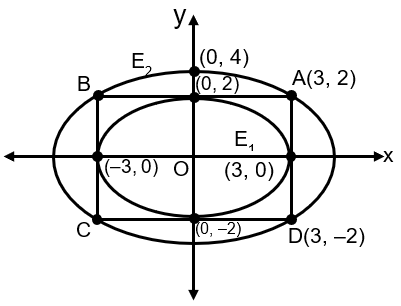The ellipse = 1 is inscribed in a rectangle R whose sides are parallel to the coordinate axes. Another ellipse E2 passing through the point (0, 4) circumscribes the rectangle R. The eccentricity of the ellipse E2 is
Equation of
Since E2 passes through (3, 2)

'e' of E2 = . Ans.
We are given two ellipses:
Our goal is to find the eccentricity of ellipse E2.
The standard form of ellipse E1 is .
Comparing with the given equation, we find: and .
For an ellipse aligned with the axes, the rectangle that inscribes it has sides parallel to the axes and touches the ellipse at its vertices. The length of the rectangle is and the width is .
Therefore, the vertices of rectangle R are at: , , , and .
Ellipse E2 circumscribes rectangle R. Since R is symmetric about both axes, it is natural to assume that E2 is also centered at the origin and has its axes aligned with the coordinate axes. Its general equation is: where A and B are its semi-major and semi-minor axes (A > B for this problem, as we will see).
We have two conditions to find A and B:
Substituting (3, 2) into the equation of E2:
Let's call this Equation (1).
Substituting (0, 4) into the equation of E2:
Let's call this Equation (2).
From Equation (2), we have found that , so .
Substitute into Equation (1):
Now, solve for A2:
Taking reciprocal:
So, the semi-axes of E2 are and .
Since B > A (4 > 2√3 ≈ 3.46), our initial assumption about which axis is major was incorrect. For ellipse E2, the y-axis is the major axis.
Let's redefine for clarity:
The formula for the eccentricity of an ellipse is: where a is the semi-major axis and b is the semi-minor axis. </